Halflings are ever the butt of the joke in Blood Bowl. Unlike their Tolkeinian brethren they are no bastions of idyllic, noble pastoralism, but a band of greedy, shiftless cheats with no more honour than your average goblin. In the real world, the Halfling team is commonly used as a self-imposed challenge by experienced players who are just too damn sick of good teams. Having said that – they are by no means the least viable of the stunty teams, with the right attitude and approach. In this guide we’ll lay out how to get the best out of these hairy little blighters.
Pros
- Cheap players keep the TV down and make replacing losses easy.
- Excellent star access that maximises the team’s upsides, and plenty of opportunities to use them.
- Solid pair of big guys which offer the most viable TTM plays in the game.
Cons
- Slow! Best MA on the team is 5, and the treemen are a measly 2.
- Fragile! Most players have armour 7+, with the exception of a very optional positional.
- Weak! Strength 2 across the board, except for the treemen, and no combat skills.
The Roster
Halfling Hopeful Lineman
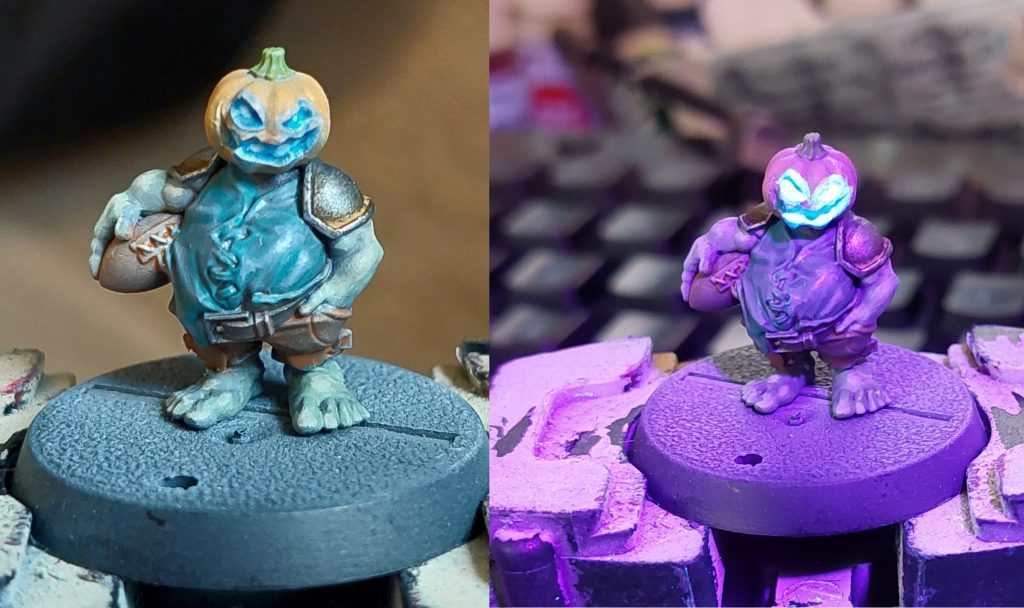
The humble ‘fling lineman is not so much the bedrock of the team as the shale of the team, maybe sandstone. They’ve got the standard set of stunty skills (Dodge, Right Stuff, Stunty), and the standard stunty stats (but a bit worse armour). However, they come cheap as chips at 30k a pop, so you can stuff an awful lot of them into your roster without needing to tighten the belt at all. And you will need them, they drop like flies.
With only Agility skill access on primaries, your skill choices are extremely limited. It’s fairly unlikely that you’ll gather up enough SPP on a single ‘fling for a secondary, and the extra expense bites into the team’s TV. That said, Sneaky Git, Diving Tackle, or Side Step are all decent advancement options. If you’ve got a ‘fling headed towards a secondary skill, Block can make for a slightly more reliable ball carrier, but Dirty Player (especially when combined with Sneaky Git) is easily the most valuable.
Due to how disposable halflings are, they’re a solid choice for a random skill. If they get something you don’t like, just fire ‘em and hire a new one.

Halfling Hefty
Something returning coaches might be surprised by is that Halflings have positionals now. Are they worth taking? Er, maybe. Coaches are somewhat divided on this issue – some prefer to run as lean a roster as possible, forgoing the bloat that the new players add, while others like to take advantage of the extra skills and skill access that the positionals bring.
The Hefty is a strange mix of things. Part line-holder, with higher armour and Fend; part thrower, with a 3+ PA stat and Passing skill access. He also can’t be thrown (too fat), lacking Right Stuff. He costs a bulbous (for halflings) 50k, with only marginal improvements, so is decidedly the most optional of the two new positionals. Arguably he has the most utility in tournament lists rather than league play, due to the Passing access opening up more skill options.
Side Step, combined with his innate Fend, can make the Hefty incredibly irritating to deal with and an effective marker. Alternatively, he can provide a cheap reroll with Leader, or act as a kick-off receiver with On The Ball.

Halfling Catcher
The most expensive of the non-tree players at 55k, the Catcher is nonetheless the more valuable of the two positionals. He’s got the standard ‘fling statline, combined with the addition of Catch and Sprint. As such, he’s the ideal guy for Throw Teammate plays. He can more easily receive the ball in a hand-off, and more easily reach the touchdown line after the throw. Unfortunately, as he is likely to be thrown (and no more likely to land) Catchers definitely have a limited shelf-life, and at their price they’re a shade more problematic to replace.
Catchers only have access to Agility skills on primary, much like the linemen. Sure Feet is a no-brainer pick, as it synergises with Sprint. Side Step or Jump Up are solid choices for further levels, though if your catcher is getting too much SPP it might be time to cut him and start again.
Altern Forest Treeman
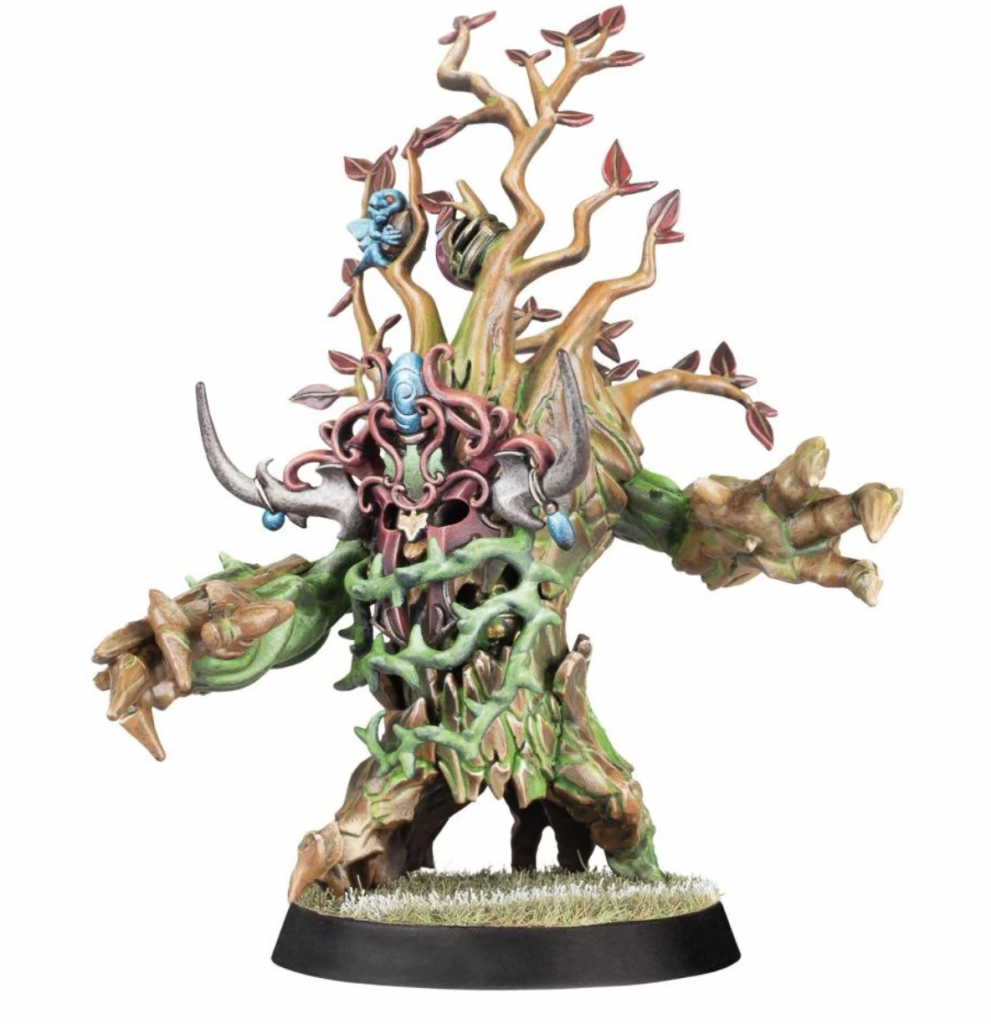
Treemen are the anchor point for the Halfling team, and provide a bit of much-needed muscle to their lines and cages. With higher strength and armour than other big guys they can dominate the LoS, but with their pathetic MA 2 and negatrait, Take Root, they’re not likely to stray terribly far from it afterwards. Getting a single assist on a strength 3 target will result in a 3-dice block, and this should be done as often as possible.
The Halfling Treeman has an additional skill over its Wood Elf cousin, the skill Timmm-ber!, which makes it easier to stand up again if they end up knocked down. Crucially, they also do not have Loner, and so are considerably more reliable! Due to Strong Arm, Treemen are easily the best TTM users in the game, only fumbling on a natural 1 no matter the distance.
While Guard is the usual first pick for players of this kind, it’s not quite as valuable due to the low number of blocks you’re likely to be doing, and the immobility of the tree. Alternatively, Grab can help keep marked targets close or manoeuvre fouling targets, even when you’re rooted, and Multiple Block is actually useful thanks to their naturally high strength. For secondary skills, Block is the best pick (surprise), but Jump Up and Sure Feet have utility too, if you should somehow end up with a chance at second secondary.
Star Players
Star players are, arguably, the MVPs of the Halfling roster, and you should aim to induce at least one in every single game. Halfling Thimble Cup and Old World Classic give access to some of the best stars in the whole game. For games against high TV teams, Morg ‘n Thorg can give you both an intimidating ball carrier and a savage blitzer; Griff Oberwald gives you an excellent all-round player, equally adept at blitzing and scoring; and Deeproot Strongbranch bolsters your treemen, allowing complete domination of the entire middle of the pitch. In lower-TV matchups, you can call on Puggy Baconbreath as a solid blitzer and ball carrier, Cindy Piewhistle for dirt-cheap bombardier shenanigans, and Helmut Wulf for gruesome fouling action. That’s not to mention Mighty Zug, Rumblelow Sheepskin (arguably not great, but come on, he’s riding a goat) and Grombrindal. It’s a buffet!
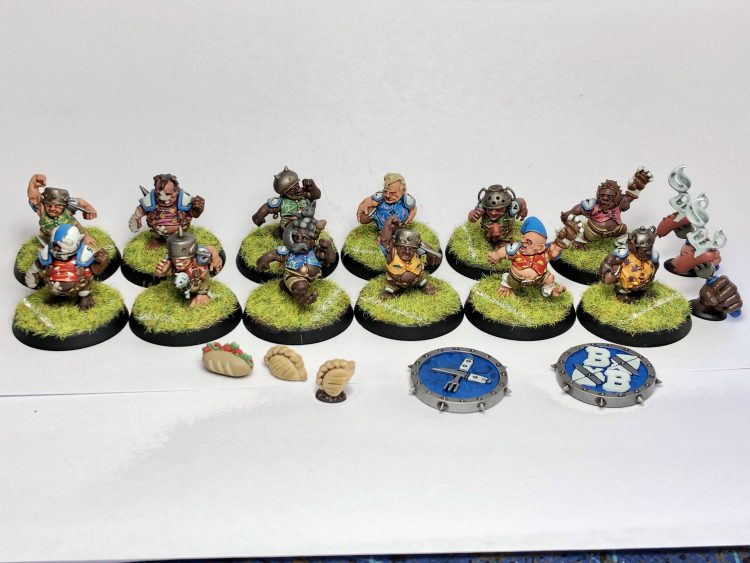
Tactics and Playstyle
Before we get into the details, it’s worth talking about Inducements. For most teams they’re a nice extra in lopsided matchups, but for ‘flings it’s the basis of their entire strategy. A Master Chef allows them to go light on rerolls while inconveniencing opponents, and the wide roster of available stars improve their odds against different opponents. Keep in mind that if you’re not getting a big sack of inducements each game, either you or your opponent is doing something wrong.
Like other Stunty teams, the Halfling playstyle is all about disengagement and tactical cheating. They rely heavily on Dodge, both passively (avoiding Defender Stumbles) and actively (dodging out of contact), to avoid getting smushed into the turf. Dodge is a fickle mistress however, and doesn’t do much good against teams with lots of Block or Tackle, so expect to rack up casualties regardless. Dodging out of danger is de rigueur, especially against opponents with Block who are very likely to get a knockdown. Just ensure that failing the dodge won’t completely screw up your entire play!
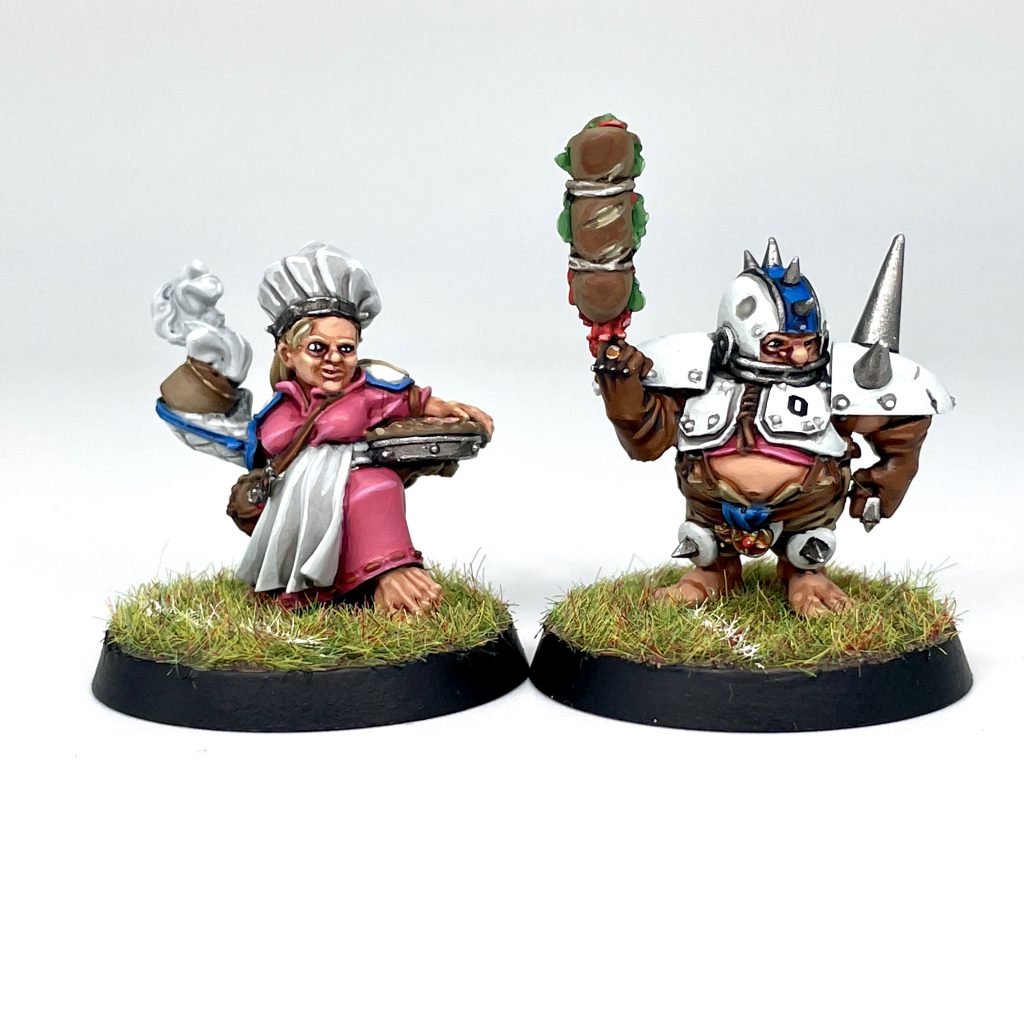
The basic Halfling offensive play is to use the Treemen to dominate the LoS and perhaps get some choice removals, and then using fouls to further whittle down numbers. If an opponent hits the dirt, you should be thinking about how best to get a foul in, especially if it’s a valuable positional. Once you’ve got a solid cage with the trees in front, you can start trying to push up the pitch. Hefties make particularly good screeners and cagers due to Fend. Ideally you’ll have a star available to carry the ball, like Griff Oberwald, Puggy Baconbreath, or even Morg ‘n Thorg. Do not rush, and try to keep play centred around your treemen as long as possible. They are your best chance at removing players and opening up fouling opportunities; outpacing them too early just allows your opponent to cut them off or pin them down. Like other slow teams, you’re looking for a turn-8 score, and should keep the TTM plays as a nuclear option if it’s looking like you won’t make it.
While not an especially good thing to be doing on every turn due to the risks involved, don’t be afraid to do the occasional TTM on a non-ball carrier in order to create a scoring threat, complete a screen, or outmanoeuvre opponents. Although it’s not a turnover, this should be avoided if you’ve already taken a lot of removals. It could just create even more.
On defence – like other stunties – Halflings have a hard time of it. Your best option is to Go Elfy – use columns and screens to cover the width of the pitch. Being slow, you’re likely to get outmanoeuvred if you commit too hard to a side or go too deep. Be patient, try and force opponents towards the treemen, and don’t be afraid to dodge out. While funny, throwing a teammate at a cage has an extremely low chance of doing anything useful, but shouldn’t be entirely discounted should you find yourself with a healthy surplus of players.
The TTM one turn touchdown is a powerful weapon in the Halfling toolbox and tends to have a higher chance of success than most opponents expect – particularly when using Catchers. A smart opponent will set-up to try and negate it as a threat, especially if you only have one turn left in the half. Pressuring an opponent to score slightly earlier will make an anti-TTM setup more of a liability for them.
Above all, the most important lesson for playing Halflings is simply this: have fun with it. You might not win many games, but you might just create some stories you’ll be telling years from now.
Starting Team Builds
League Play
The most TV efficient lineups require buying an extra sprue or box of ‘flings to cover the extra linemen, but first let’s looking at a roster that works with just the one box (plus trees):
2x Altern Forest Treeman
2x Halfling Catcher
1x Halfling Hefty
8x Halfling Hopeful Lineman
1x Reroll
700k
We’re a little light on players, but have plenty of inducement money to get a Chef and a star or two. Now let’s look at a more TV efficient roster:
2x Altern Forest Treeman
1x Halfling Catcher
11x Halfling Hopeful Lineman
1x Reroll
685k
The Hefty is expensive and is questionably worth it, so we’re ditching him. We’re taking one Catcher, with the aim of keeping him on the bench for a TTM play. We’ve also got a fat roster of 14 players, with plenty of cash for stars and a Chef on top of that (remember that stars count towards your max 16 players!) One of the Linemen can easily be swapped for a second catcher at minimal cost, but it’s very optional.
League Development
Your main aim as the team develops is to keep your TV in a good band, not so high as to cut off your available inducements. If need be, fire players that are getting too expensive. As such, your development options are going to depend on the state of your league. Assuming you have the space, a second reroll won’t hurt, and a second catcher or even picking up a hefty can be valuable. But remember, priority one is keeping your TV in the golden range.
Tournament Builds
The best option here is going to depend on the tournament in question; many now have house rules in places that affect the price and availability of certain high-tier stars. Assuming the standard pricing, here’s an example for 1.15m gold:
2x Altern Forest Treeman
2x Halfling Catcher
1x Halfling Hefty
8x Halfling Hopeful Lineman
1x Reroll
1x Assistant Coaches
Griff Oberwald
Cindy Piewhistle
Halfling Master Chef
Dropping the Hefty and the Assistant Coach can get you a second reroll, but in practice Halflings use their rerolls for pick-ups and the occasional Treeman dub or triple skull, so the Master Chef should give you enough…most of the time.
Tournament Skills
Any secondary skills should be Block, on one or both treemen and possibly a Catcher, then at least one Dirty Player lineman. After that, a healthy sprinkling of Side Step and Sneaky Git. The Hefty is at his most useful here, as you can slap on Leader if you’re feeling short on rerolls, or On The Ball for an easier time retrieving the initial kick-off (which can make a big difference against fast teams, like Skaven, Elves, or Lizards).
Tiers
Halflings are inarguably Tier 3 (or lower, if the tourney uses more tier categories). Although their star access gives them a fighting chance, they have a very high skill ceiling and rely heavily on luck. On the plus side, this generally gives them lots of extra skills and good star access!
Once you’ve extricated yourself from beneath the boot of the nearest halfling-stomping big guy, why not send any comments, feedback, suggestions or ideas to contact@goonhammer.com.
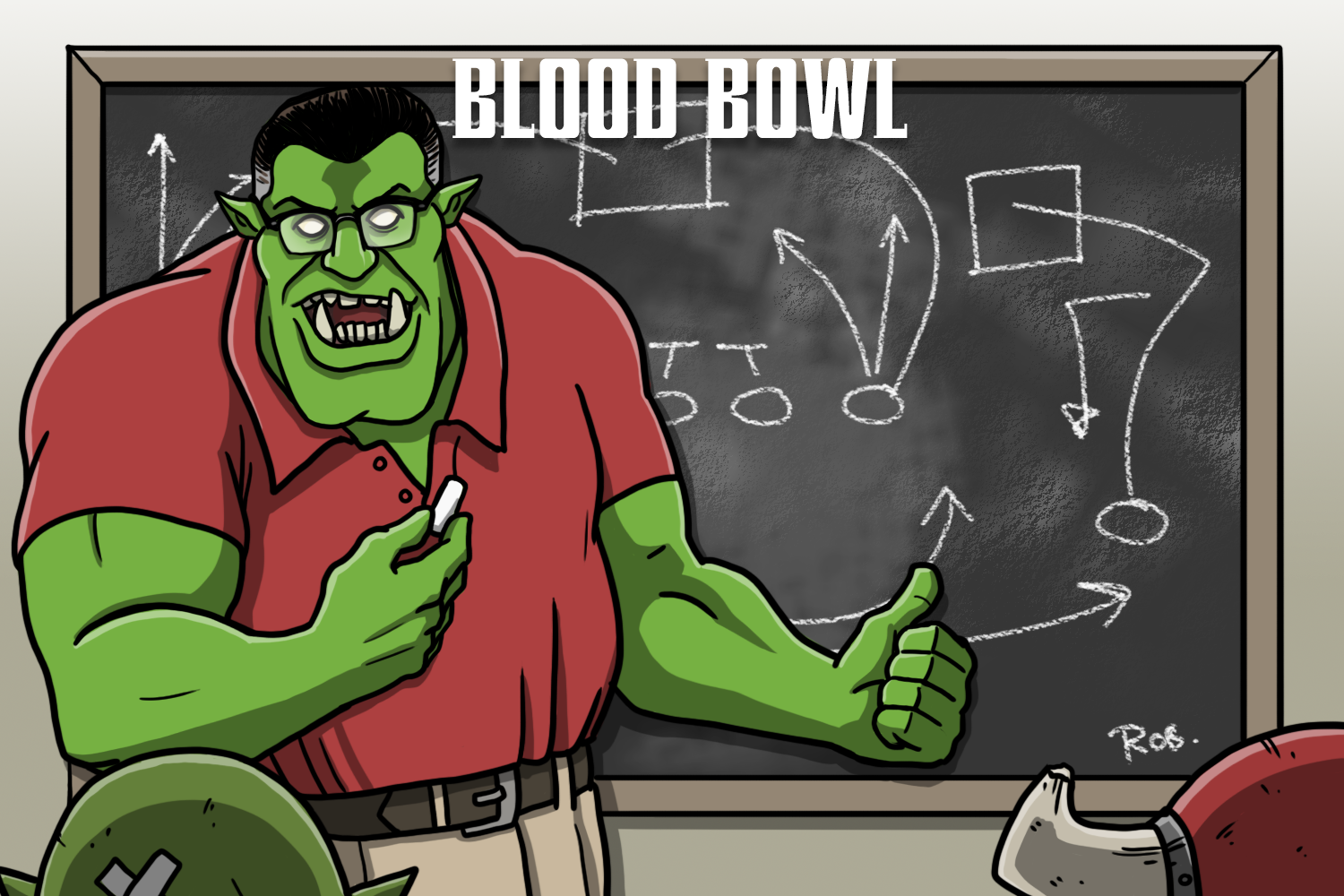


You must be logged in to post a comment.